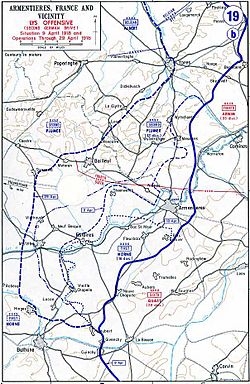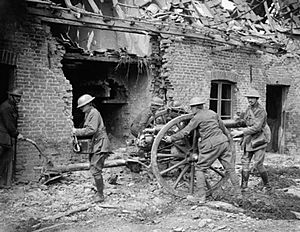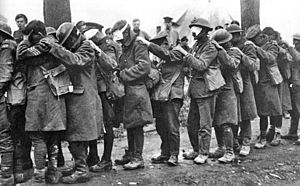Battle of the Lys (1918) facts for kids
Quick facts for kids Battle of the Lys |
|||||||||
|---|---|---|---|---|---|---|---|---|---|
| Part of the Western Front of the First World War | |||||||||
 German Lys offensive, 1918 |
|||||||||
|
|||||||||
| Belligerents | |||||||||
|
|||||||||
| Commanders and leaders | |||||||||
|
|
||||||||
| Strength | |||||||||
| Unknown | 35 divisions (~612,500) | ||||||||
| Casualties and losses | |||||||||
|
|
||||||||
The Battle of the Lys, also known as the Fourth Battle of Ypres, was a major fight during World War I. It took place in Flanders, a region in Belgium and France. The battle lasted from April 7 to April 29, 1918.
This battle was part of a larger German plan called the German spring offensive. The main goal was to capture the city of Ypres and push British forces back. The Germans wanted to cut off the British from their supply ports on the English Channel. This would hopefully force Britain out of the war.
Contents
- Background to the Battle
- Key Moments of the Battle
- Battle of Estaires (April 9–11)
- Battle of Messines (April 10–11)
- Battle of Hazebrouck (April 12–15)
- Battle of Bailleul (April 13–15)
- Withdrawal from Passchendaele Ridge
- Battle of Merckem (April 17)
- First Battle of Kemmel (April 17–19)
- Second Battle of Kemmel (April 25–26)
- Battle of the Scherpenberg (April 29)
- Aftermath of the Battle
Background to the Battle
Where the Battle Happened
The battle zone stretched from Ypres in Belgium to Béthune in France. This area was about 40 kilometers (25 miles) long. The Lys River ran through the middle of this battle area.
The Allied forces held the front line. The Belgian Army was in the far north. The British Second Army and British First Army held the center and south.
German Attack Plan
The German army had a clear plan. They wanted to break through the British First Army. Then, they would push the British Second Army north. Their final goal was to reach the English Channel. This would cut off British supply lines from ports like Calais and Dunkirk.
The German attacking forces were the Sixth Army and the Fourth Army. These armies included many new stosstruppen. These special soldiers were trained to lead attacks using new "storm tactics."
The British First Army was not very strong at this time. It had tired soldiers and some units that were not fully staffed. This included two divisions from the Portuguese Expeditionary Corps. These Portuguese soldiers had low morale and were supposed to be replaced soon.
Key Moments of the Battle
Battle of Estaires (April 9–11)
The German attack began with heavy shelling on April 7. On April 9, the German Sixth Army attacked with eight divisions. They hit the Portuguese Second Division very hard. The Portuguese soldiers fought bravely but were overwhelmed. They had to retreat after hours of intense fighting.
The Germans broke through about 15 kilometers (9 miles) of the front line. They advanced up to 8 kilometers (5 miles). Their furthest point reached Estaires on the Lys River. British reserve troops finally stopped them there. On April 10, the Germans tried to push further but were held back. They did manage to capture Armentières.
Battle of Messines (April 10–11)
On April 10, the German Fourth Army attacked north of Armentières. They faced the British 19th Division. The British Second Army had sent its reserves south. This meant the Germans broke through and advanced about 3 kilometers (2 miles). They captured Messines.
By April 11, the British situation was very serious. It was on this day that General Haig gave his famous "backs to the wall" order. This meant his troops had to fight to the very end.
Battle of Hazebrouck (April 12–15)
On April 12, the German Sixth Army attacked again. They moved south towards Hazebrouck, an important supply center. The Germans advanced a few more kilometers and captured Merville. However, on April 13, the First Australian Division arrived. They helped stop the German advance.
Battle of Bailleul (April 13–15)
From April 13 to 15, the Germans pushed forward in the center. They captured Bailleul, west of Armentières. But British resistance was growing stronger.
Withdrawal from Passchendaele Ridge
The British Second Army had to pull back from the Passchendaele area. This was a strategic move to shorten their lines and save troops. The withdrawal happened between April 11 and 16. The Germans did not realize the British were pulling back for some time.
Battle of Merckem (April 17)
On April 17, the Belgian Army fought off a German attack. This happened near Houthulst Forest. The Belgians, with help from British artillery, held their ground. They pushed the Germans back and restored their lines.

First Battle of Kemmel (April 17–19)
The Kemmelberg is a tall hill that overlooks the area. From April 17 to 19, the German Fourth Army attacked this important hill. However, the British forces successfully defended it.
Second Battle of Kemmel (April 25–26)
French General Ferdinand Foch was now in charge of all Allied forces. He sent French troops to help in the Lys sector. A French division took over defending the Kemmelberg.
From April 25 to 26, the German Fourth Army launched a surprise attack. They captured the Kemmelberg. While this was a success for the Germans, it did not lead to a major breakthrough in the Allied lines.
Battle of the Scherpenberg (April 29)
On April 29, the Germans made one last attack. They captured the Scherpenberg, another hill near the Kemmelberg. This was the final major action of the battle.
Aftermath of the Battle
Casualties
The Battle of the Lys was very costly for both sides.
- The British suffered about 82,000 casualties (killed, wounded, or missing).
- The French had about 30,000 casualties.
- The Germans had between 86,000 and 109,300 casualties.
A famous German pilot, Manfred von Richthofen, known as the "Red Baron," was killed during this battle.


